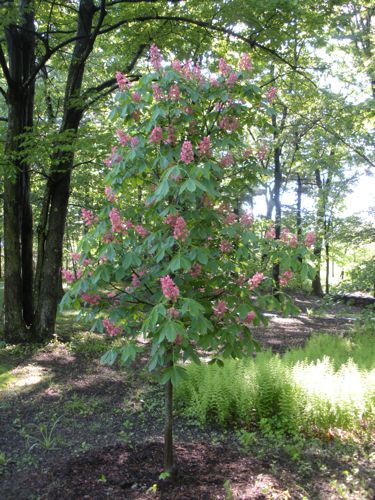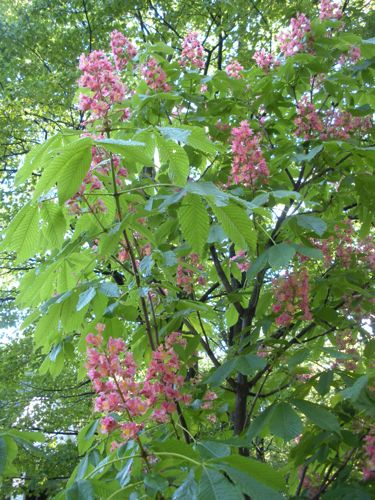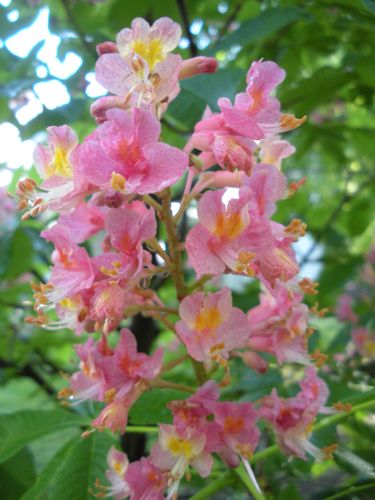I’m lucky to live in a corner of New England that has historic buildings, dating from the Colonial Period of the 1700’s and into the 1800’s. A mile from my home is a house that was built in the 1750’s. Somehow, the property lines have stayed intact since then. Stone walls still mark the border between hay fields and woods. Of course, the landscape has changed over the years. The road is now black pavement and much closer to the front door than the original dirt tract. Powerlines bisect the view. But not all change is bad – the trees that were planted 200 years ago are now full-blown beauties. One of them is a Red Buckeye that reaches thirty feet. Although tree guides say that the Red Buckeye is a native of the southeast, and is more shrub than tree, this one proves otherwise. The tree is not easy to find at local nurseries, but my landscaper, Mark, found one and planted it a couple of years ago in my front yard.
Those pinky-red bottlebrush blooms are why I wanted this tree. It’s old-fashioned, yet dramatic.
I took these photos early this morning, after a heavy rain. When the sunlight reaches the tree in another hour, it will be covered with buzzing bees.
Pollinators, especially honeybees, are in decline. Many showy plants at garden centers look pretty, but are like candy – they have no nutritive value. Last year I went on a garden tour in a neighboring town. One of the gardens was in a newer development. I walked around the block and felt uneasy. Something was amiss, but I couldn’t figure out what it was. The next garden was at an older home, and bordered wetlands. At that garden there was birdsong and insect noises. It sounded alive. I realized that as pretty as the homes were in that new development, that it was deadly quiet there. Hopefully, some of the residents will plant Red Buckeyes.
(There’s a new book for children about the crisis with honeybees, The Hive Detectives. It should be in every school library.)




Terry I know what you mean about newer developments. Wouldn’t live in one if you gave me the house.
Around here they will take a beautifully wooded area cut down every living green thing, build the homes and then plant twigs in the front yards!!!! AMAZES ME!!!!!
Logically you would think they could charge a premium for the lot if they had mature shade trees on them.
Our backyard was razed by a spec builder who was going to put up a house here. Luckily, we got the lot before the front trees went, too.
Not 10 minutes ago I was chatting with a co-worker outside (we’re teachers) and we noticed honeybees busy with the clover!
I love bees!
My whole backkyard buzzes when the clover blooms! I have to be careful not to go out in barefeet.
My neighbor was scared to death when a giant cluster of bees took up in one of her trees…she called an exterminator. I immediately went to her house and told her not to worry…they just stopped to rest! Sure enough, they stayed a while and then left. One of the few times I was right! It would be a sad place without the bees!
Sad and empty. Not to mention my vegetable garden useless!
Do you have May and June bugs over there? Big chafers with huge feathery antennae. They feed on the flowers of Buckeyes and Horse Chestnuts and seem to spend all evening crashing into our windows if we have the lights on.
Send me a link with photos of your June bugs. We have bugs of similar names, but I don’t recall feathery antennae. Right now, the gray tree frogs are making a huge ruckus. They’re awfully cute, too.
good old Wiki!
http://en.wikipedia.org/wiki/Cockchafer
the grubs of these beetles live in the soil – a nightmare if you have foxes or badgers about as they dig the lawn up looking for them. The chickens love them too. I see now the antennae aren’t feathery, I think I was getting carried away! They’re more like little hands waving.
Hi Wendy- I’m sure we have June bugs like you have, but what we call a June Bug around here are the Japanese Beetles – those ravenous imports that eat down rosebushes first, then go on to everything else. A pretty emerald green, but nothing else one can say good about them. Their grubs infest and destroy lawns. The chickens, of course, love them! My favorite day in June is the first hot one, when masses of beetles emerge at one time. I let the chickens loose and they run back and forth catching the beetles. Hilarious, and I’m very grateful.
We put in a Buckeye last year. About 3 feet tall. My neighbors have white blooms on theirs. This was a gift from them.The bees love the blooms and the squirrels love the nuts..(Not sure I`ll love that)
I’ve only seen the red ones around here. Sounds pretty. I haven’t seen a lot of nuts yet… am sure the goats will love them!